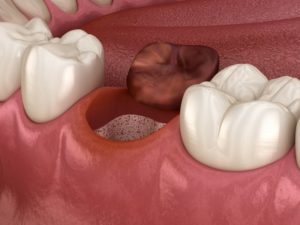
You’ve likely heard of dry socket and its notorious reputation of being a condition that you never want to experience, but do you actually know what it is? If you’re having a tooth extracted, you’ll want to understand how this condition develops and ways you can avoid it, as it can lead to serious pain and post-operative complications. Read on to learn more about dry socket and ways to protect your healing extraction site from it.
What is Dry Socket?
After a tooth is extracted, a blood clot will form in the socket where the roots once lived to help the underlying soft and hard tissues heal. It’s crucial to keep the clot intact for healing to continue. If it becomes dislodged for any reason, it could lead to dry socket, a post-operative, painful complication that slows down healing and can put your extraction site at-risk of becoming infected.
Ways to Prevent Dry Socket from Developing
There are several ways you can prevent dry socket, many of which simply avoid placing strain on the vulnerable blood clot protecting your bone and soft tissue:
- Don’t Use Straws: The suction caused by drinking from a straw can easily dislodge the blood clot, so be sure to avoid straws for at least a week following your surgery.
- Avoid Tobacco & Smoking: To boost your recovery, stop smoking and using tobacco products directly before and after your tooth extraction.
- Eat a Soft Diet: Post-operative instructions will likely include eating a soft diet for several days following your surgery. Be prepared beforehand by going grocery shopping for foods like applesauce, yogurt, smoothies, and mashed potatoes.
- Maintain Good Dental Hygiene: You won’t be able to brush your teeth like you normally would after your tooth extraction because the bristles from the brush and vigorous rinsing and spitting could dislodge the blood clot. Instead, gently rinse saltwater around your mouth three times a day, drink plenty of fluids, gently brush your teeth, being sure to avoid your extraction site, and avoid strenuous activity following your procedure.
Symptoms of Dry Socket
There are several signs of dry socket, but one of the most common is pain at the extraction site. Some others include:
- Swelling and soreness
- Visibly empty socket
- Partially missing blood clot
- Pain that radiates outward to the face and head
- Visible bone
- Bad breath
If you believe that you have dry socket, you need to contact your dentist immediately for an emergency visit. The good news is that this condition is treatable by medication and pain management, so after you visit your emergency dentist, you should quickly begin to feel better.
About the Author
Dr. Nancy Cabansag has over 20 years of experience as a dentist, which means she’s successfully extracted hundreds of teeth! She provides her patients who are in pain with fast and reliable, pain-relieving care, which is why she offers same-day emergency appointments. For those with toothaches, she also provides a dental special that includes an exam and X-rays for $49. If you have questions or need urgent treatment, visit Encore Dentistry’s website or call 817-508-9881.
